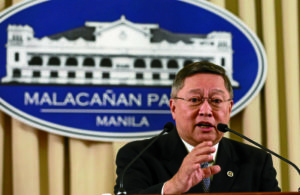The Bangko Sentral ng Pilipinas yesterday assured the public that solid fundamentals would keep the peso in check even as the domestic currency fell to the 51:$1 level this week.
“In the foreign exchange market, firm macroeconomic fundamentals will continue to provide stability to the peso despite the recent spate of depreciation pressures,” BSP Governor Nestor A. Espenilla Jr. told senators during a briefing on the proposed P3.77-trillion national budget for 2018.
The peso yesterday shed a centavo to close at another low in almost 11 years of 51.35 to $1, the weakest level since Aug. 25, 2006’s 51.38.
At the Philippine Dealing System, the peso touched an intraday low of 51.60 and a high of 51.30 after opening at 51.45 to a greenback.
The total volume traded jumped to $824.7 million from $659 million last Tuesday.
Espenilla explained that the peso’s weakening of late partly reflected market concerns on the turn to deficit of the country’s current account balance despite the fact that macroeconomic fundamentals remained sound.
In the first quarter, the current account deficit of $318 million reversed the $730-million surplus a year ago as the trade-in-goods deficit further widened due to a surge in imports.
For 2017, the BSP expects the current account to swing to a $600-million deficit from last year’s surplus of $600 million as the projected 10-percent growth in imports would outpace the 5-percent exports growth.
“However, it should be emphasized that the current account position signals the country’s higher propensity to import as the country gears up for higher growth momentum. The Philippines is one of the fastest-growing economies in the region, arguing for higher imports to support the projected higher growth path,” Espenilla said.
The BSP chief added that the peso was “normalizing” following “sustained past appreciation.”
“Thus, looking at the real effective exchange rate, the peso gained external price competitiveness against its trading partners due to the combined effects of the peso’s nominal depreciation and lower consumer prices against these currency baskets,” according to Espenilla.
For the BSP, the recent decline in the peso should have minimal effects on the country’s macroeconomic conditions over the medium term, Espenilla said.
“For instance, it takes a permanent P1 per dollar depreciation to raise inflation by about 0.15 to 0.2 percentage point over a two-year period. This limited impact gives the BSP flexibility to take a longer-term view of the peso,” Espenilla explained.
As such, Espenilla said “the peso is also expected to be broadly stable for the medium- to long-term.”


